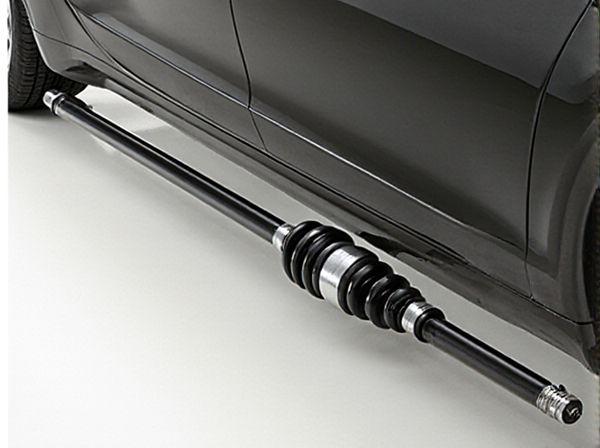
Photo illustration: Lightweight Driveshaft vs Heavy-Duty Driveshaft
Lightweight driveshafts improve vehicle performance by reducing rotational mass, which enhances acceleration and fuel efficiency. Heavy-duty driveshafts provide superior strength and durability, making them ideal for towing, off-roading, and high-torque applications. Choosing the right driveshaft depends on your vehicle's intended use and performance requirements.
Table of Comparison
| Feature | Lightweight Driveshaft | Heavy-Duty Driveshaft |
|---|---|---|
| Material | Aluminum or carbon fiber | Steel or reinforced alloys |
| Weight | Low (reduces rotational mass) | High (designed for strength) |
| Torque Capacity | Up to 600 Nm | Up to 1500+ Nm |
| Durability | Moderate, optimized for performance | High, built for heavy loads |
| Applications | Sports cars, performance vehicles | Trucks, off-road vehicles, towing |
| Cost | Higher due to advanced materials | Moderate to high, based on build |
| Vibration Resistance | Good, reduces drivetrain strain | Excellent, designed for heavy use |
Introduction to Driveshaft Types
Lightweight driveshafts are designed using materials such as aluminum or carbon fiber, offering reduced rotational mass and improved vehicle acceleration. Heavy-duty driveshafts, typically constructed from steel or reinforced alloys, provide enhanced durability and torque capacity for demanding applications like trucks and off-road vehicles. Selecting between these driveshaft types depends on factors like vehicle performance requirements, load conditions, and intended use.
Key Differences: Lightweight vs Heavy-Duty Driveshafts
Lightweight driveshafts typically use materials such as aluminum or carbon fiber, reducing rotational mass and improving vehicle performance through better acceleration and fuel efficiency. Heavy-duty driveshafts are constructed from steel or reinforced alloys, designed to withstand higher torque and torque fluctuations in demanding applications like off-road or heavy towing. The key difference lies in strength versus weight trade-offs, with lightweight driveshafts prioritizing efficiency and heavy-duty driveshafts emphasizing durability and load capacity.
Materials Used in Driveshaft Construction
Lightweight driveshafts are typically constructed from advanced materials such as carbon fiber or aluminum, which offer high strength-to-weight ratios and improved fuel efficiency. Heavy-duty driveshafts utilize robust materials like steel or reinforced alloys to withstand greater torque and harsh operating conditions. Material choice directly impacts the driveshaft's durability, performance, and application suitability in automotive and industrial contexts.
Performance Benefits of Lightweight Driveshafts
Lightweight driveshafts enhance vehicle performance by reducing rotational mass, leading to quicker acceleration and improved fuel efficiency. Their superior responsiveness and lower inertia minimize drivetrain vibrations, contributing to smoother power delivery. Compared to heavy-duty driveshafts, lightweight options also reduce stress on bearings and transmission components, increasing overall drivetrain longevity.
Durability and Strength of Heavy-Duty Driveshafts
Heavy-duty driveshafts are engineered with reinforced materials such as high-strength steel or chromoly, providing superior durability and resistance to torsional stress under heavy loads. Their enhanced construction minimizes the risk of fatigue and failure in demanding conditions like off-road or commercial vehicle applications. This robustness ensures sustained performance and longevity compared to lightweight driveshafts, which prioritize weight reduction over ultimate strength.
Application Scenarios: Choosing the Right Driveshaft
Lightweight driveshafts excel in high-performance sports cars and racing applications where reducing rotational mass enhances acceleration and handling. Heavy-duty driveshafts are essential in commercial trucks, off-road vehicles, and industrial machinery, providing superior durability and torque capacity under extreme loads. Selecting the right driveshaft depends on the vehicle's operational demands, prioritizing weight savings for speed and efficiency or strength and resilience for heavy-load resistance.
Impact on Vehicle Efficiency and Fuel Economy
Lightweight driveshafts reduce rotational mass, leading to improved vehicle efficiency by minimizing energy loss and enhancing acceleration response. Heavy-duty driveshafts, while more robust for towing or heavy loads, increase rotational inertia, which can negatively impact fuel economy by requiring more engine power during acceleration. Choosing the appropriate driveshaft depends on balancing durability needs with the desire for optimized fuel consumption and overall drivetrain performance.
Maintenance Requirements and Longevity
Lightweight driveshafts typically require less frequent maintenance due to reduced rotational mass, which decreases wear on bearings and joints, enhancing overall drivetrain efficiency. Heavy-duty driveshafts, designed for high torque and load capacity, demand regular inspection and lubrication to prevent premature failure from increased stress and fatigue. Proper maintenance extends the longevity of both types, but heavy-duty driveshafts generally have a shorter lifespan if maintenance protocols are neglected due to higher operational strain.
Cost Comparison: Lightweight vs Heavy-Duty
Lightweight driveshafts typically cost less upfront due to lower material and manufacturing expenses, often using aluminum or carbon fiber composites, which reduce weight and improve fuel efficiency. Heavy-duty driveshafts, built from steel or reinforced materials, demand a higher initial investment but offer superior durability and load capacity, making them cost-effective for heavy-load or off-road applications. Long-term costs vary depending on usage; lightweight driveshafts may incur more frequent replacements under high stress, while heavy-duty driveshafts reduce maintenance and downtime in demanding environments.
Conclusion: Selecting the Optimal Driveshaft
Choosing the optimal driveshaft hinges on vehicle application and performance needs, where lightweight driveshafts excel in reducing rotational mass for improved acceleration and fuel efficiency. Heavy-duty driveshafts offer superior strength and durability, ideal for trucks or off-road vehicles subjected to high torque and harsh conditions. Evaluating factors such as load capacity, material composition, and driving environment ensures the selection of a driveshaft that maximizes reliability and driveline efficiency.
 caratoz.com
caratoz.com